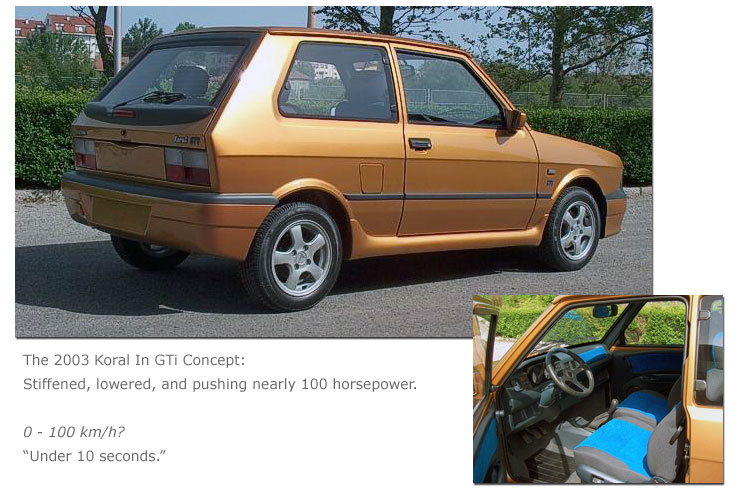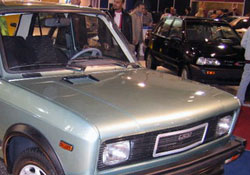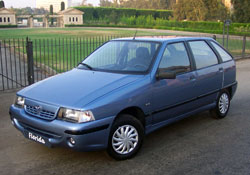In 2003, Zastava Automobili receives an extended JUS ISO 9001 quality certificate, after Germany's Certification Agency TUV Bayern Sava finds that the Serbian automaker had met all requirements for the extension. According to Serbian Directorate for Quality Director Dejan Marković, preparations are under way for ISO TS 16949 certification.
Zastava hopes to raise its output from 1,200 vehicles per month to 10,000 within three years, under a new joint venture with New Jersey-based NUCARCO, announced in the Fall of
2002. 75% of the company's output is to be shipped to the U.S.; the EU, and to developing markets.
Concept: Koral In GTi
With sales of its new
In range climbing, Kragujevac shows a new concept at the 2003 Belgrade International Motor Show: the Koral In GTi, a sub-900kg, ~100hp pocket rocket powered by a 1.6-liter PSA/ Peugeot-Citroën engine.

The Koral In GTi's chassis has been stiffened in several spots, notably, at the front subframe; strut towers, and B-pillar, its body subsequently lowered for stability at a top speed of 180 km/h. Larger, ventilated disc brakes feature all-around. 100 km/h flashes by from rest in under 10 seconds.
The promise of Zastava Motor Works (ZMW)
February 23rd, 2003, sees Malcolm Bricklin, president of Zastava/ ZMW importer-to-be NUCARCO, announce that a $175 million investment will be required for Zastava to produce vehicles for the U.S. market, $25 million of which in tooling for redesigns, and another $15 million for worker pay increases and various other structural changes. It is evident from Bricklin's words that he seeks to sell not a truly affordable car but, rather, one costing as much as $10,000.
"Our U.S. marketing research, which we have conducted largely with the new Cabrio, has resulted in people saying, yes, I want that car," Bricklin muses.
Amid fears that ZMW might price itself out of the budget market in which Zastava is traditionally strongest, Bricklin suggests that, with the investment he proposes, Zastava might be able to produce hybrid cars. Zastava has, after all, already experimented with electric cars (note the
2000 Yugo Elektra Concept). He explains that the use of such technology would enable the retaining of the 4,700 people who must, under the terms of the agreement, be kept employed.
At the same time, Bricklin also indicates that he is contemplating distributing Zastava vehicles in South and Central America, and in the Carribean, where regulations are less strict.
On December 1st, 2003, normal trade relations between Serbia-Montenegro and the United States resume. The move restores Permanent Normal Trade Relations status (PNTR), which the country (then Yugoslavia) lost in 1992 as a result of the Yugoslav Civil War.
Before the conflict, Yugoslavia and the United States had enjoyed a reasonable trade balance. In addition to Zastava's Yugo being exported to the United States between
1985 and
1991, numerous other high-value products were produced for the U.S. across Yugoslavia, including spare parts for Boeing aircraft (manufactured in two Serbian towns: Pančevo, and Trstenik).
The restoration of normal trade relations creates the conditions for Serbia's products to enter the United States market at 20% lower tariffs. It is a much-anticipated move; in the first eight months of 2003, the value of Serbia's total foreign exports stood at a modest $116.9 million, with exports to the United States accounting for just $8.4 million.
The move also clears the way for ZMW.
ZMW's range would have consisted of a
Koral In-based three-door hatchback and convertible, and of
Florida In-based four-doors; five-doors, and pickup trucks. Suddenly, the American media was talking about Zastava again. The sheer unlikelihood of ZMW's availability could, they said, add color that nondescript budget vehicles such as Kia's had failed to provide.
Yugo's brand recognition remained very much alive in the U.S. Launching a brand in the American market cost, according to author Eric Davison, $100 million in advertising
(Snake Bit, Eric Davison, Motorbooks, 2004). This, then, is a major barrier to entry over which ZMW/ Yugo would have leapt.
Moreover, the promise of technical merit in the form of a contemporary, deliciously delicate (for this category) drivetrain was on the table, courtesy of Peugeot, whose engines were being installed in Zastava vehicles as of
2002.
Modern, Peugeot engines were planned for the U.S. The potential this might have created for an eventual Peugeot return, as well as for small cars that featured the economy of diesel in the American market, cannot be overlooked. Why was Volkswagen the only small-car diesel player on the U.S. market? Why must budget cars feature horrible stick-shift transmissions? Not one stick-shift Kia had any of the brio of even the original Yugo's 'box. The 2004 Chevrolet Cavalier's Getrag was a decent unit, but at a price premium far above that at which the ZMW's French
joie-de-vivre shifter would have been offered.
With Peugeot's interest in a potential return, one might assume that the French company would have taken care to ensure adequate parts-manufacturing standards and distribution. Additionally, a modern engine requires less upkeep, and so it might have been feasible for ZMW to offer free basic maintenance for the first few years of ownership, offsetting both owner neglect (as in the case of the original Yugo) and low resale values.
Circumstances had begun repeating themselves. Gas prices had climbed, although (as at the time of the Yugo's U.S. introduction in the summer of 1985) not to the level of a crisis. Moreover, just as when the original Yugo had appeared at the L.A. Auto Show in the Winter of 1984, Chevrolet had brought in a Far East-derived subcompact in the form of the Aveo budget hatchback.
Nothing comes of ZMW
ZMW was not simply about demonstrating to buyers the benefits of low-cost transportation. Instead, its potential lay in the return of a plucky underdog and of Peugeot drivetrains; in an education – directed at American buyers – of the benefits of low-weight vehicles; in a demonstration of what a shoe-string budget might engender (similar to cash-strapped MG-Rover's 2004 conversion of the front-wheel-drive Rover 75 to a rear-wheel-drive sports sedan), and in the potential promise of French, common-rail diesel engines (with the uniqueness; reliability, and economy that implies).
Yet, by mid-2003, it was gradually becoming clear that nothing would come of Bricklin's fledgling NUCARCO import operation.
As
Motor Trend had once said, back when the Yugo had exited the U.S. market in 1991,
"it's a pity... America needs a car like the Yugo." Even as the ZMW deal collapsed, Yugo enthusiasts in the United States continued to swear by their cars' reliability. With the help of, most notably, Orion Automotive, they kept their Yugos going; some had seen the odometer turn over more than twice. Launched in 1995 as a dealer in Fiat equipment, Orion now did virtually all of its business in Yugo parts. Five days a week, the company shipped out somewhere between 15 and 20 packages.
"It was designed for small cities in Yugoslavia, so small towns are the Yugo's natural environment," Orion's owner, Hadrian Swager, told
USA Today in 2002.
As of 2003, Jay Pierce – at (800) 736-6410,
http://www.yugoparts.com - was enthusiastically continuing Mr. Swager's work.
Swager noted that most of his parts did not cost a lot of money, citing a $12.10 – shipped – window crank as one of the most popular items.
It seemed fitting. Bricklin had always said that his goal was to get owners of budget cars
"feeling smart about their choice." The Zastava 128 is gone, but not forgotten

The 128 remained wildly popular in Egypt, so El Nasco and Zastava signed a contract for the shipment of 3,000 CKD kits per year, including the Florida In (below)

December 2003 saw the last Zastava 128 sedan leave Kragujevac lines. Yet the car remained wildly popular in Egypt, where taxi drivers - in particular - praised its longevity.
Thus El Nasco and Zastava signed a contract for the shipment of 3,000 unassembled cars per year for the Egyptian market. El Nasco began assembling the Zastava 128 in April 2003.
On February 28th, 2003, Zastava also shipped 240 unassembled CKD Florida In models to Egypt, through Montenegro's port Luka Bar. Both the 128 and Florida In continued to be sold in Egypt by longtime Zastava partner Yugo MISR Trade (
http://www.yugomisr.com), which had in total sold more than 86,000 Zastavas.
The high-revving design of the 128's engine lent itself well to tuning. High-overlap, high-duration cam profiles fit this engine better than they might more traditional, square and undersquare engine designs. In 2003, Serbian engineer Nikola Radenković is inspired to produce a custom MPI system for Weber-Marelli-derived fuel injection.
The system is uncommonly programmable, allowing for Fiat/ Lancia SOHC engines to be tuned to more than 90 horsepower per liter of displacement, with bolt-on components courtesy the Fiat/ Lancia parts bin.
Serbia in 2003 imported cars worth $533 million in total, which suggested that Serbia's trade deficit, and the country's reputation as a graveyard for used and abused elderly European machinery, were on the rise.
With Zastava now producing
Euro 3 models, mandatory emissions standards for imported cars would be on the way.